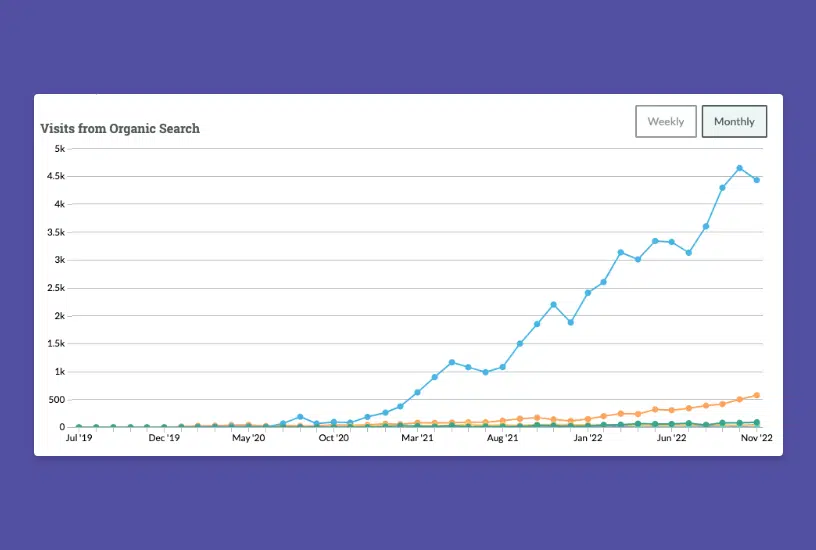40+ Website Key Performance Indicators to Measure Your Websites Performance

Understanding how your website is performing is critical for improving performance.
You can’t optimize if you don’t understand the current situation.
In marketing, campaign performance is tracked using Key Performance Indicators, or KPIs for short. Simply put, these metrics indicate how well the campaign is performing.
Having KPIs is not enough to be successful, they need to be the right KPIs. Bad KPIs are worse than no KPIs. Bad KPIs point you in the wrong direction, preventing you from spotting and correcting performance issues.

This article will discuss the most common website key performance indicators and how to select them.
Let’s start by talking about the two types of key performance indicators: leading and lagging.
Leading vs Lagging Indicators
There are two categories of key performance indicators, leading and lagging. Leading indicators influence outcomes but don’t measure the outcome itself, whereas lagging indicators measure the outcome.
For example, if you have an eCommerce website, one of your KPIs will be online revenue. This is a lagging indicator, you’re measuring the desired outcome. Online revenue doesn’t happen in a vacuum, some factors influence online revenue, including traffic, conversion rate, etc… these are examples of leading indicators.
You can spot changes and issues before you’ve missed a goal by measuring leading indicators. If traffic and conversion rates drop early in the month, you can make adjustments to correct the issues and get back on track.
Let’s start by discussing lagging indicators because your leading indicators will be based on your lagging indicators.
Lagging Indicators
Every website exists for a reason: to generate leads, increase online sales, build brand awareness, or provide customer support. Your lagging indicators measure how successful the website is at achieving those goals.
If you haven’t defined your website’s goals, start there.
It’s important to note that the most effective website goals follow the SMART format. Specific, Measurable, Achievable, Relevant, and Time-Bound. This topic could be it’s own article, so I recommend reading the linked resource above if you’re unfamiliar with the format.
Once you’ve defined your website goals, you can identify the Key Performance Indicators to measure them.
Common examples include:
Lead Generation
- Contact form submissions
- Request a demo form submissions
- Newsletter sign-ups
- Content offer opt-ins
- Calls from website
- Meetings booked
- Chat bot engagements
Online Sales
- Online sales (quantity)
- Online sales (volume)
Brand Awareness
- Branded search volume
- Non-branded search engine visibility
- Website traffic
- Social followers
- Newsletter size
- External links
Sales Support
- Engagement on case studies, service, and about pages
- Middle and bottom of the funnel content opt-ins
Now let’s move on to leading indicators.
Leading Indicators
Leading indicators are based on your lagging indicators. Each lagging indicator will be influenced by several factors, some of which can be measured.
To simplify the process, we group leading indicators into categories.
Acquisition
Your website can’t be successful without visitors. Getting the right people to your website is an essential requirement. Tracking the quantity, quality, and source of visitors is a universally beneficial leading indicator. Fluctuations in visitors can be spotted earlier, diagnosed, and addressed.
Common traffic KPIs include:
- All traffic
- Search traffic
- Referral traffic
- Direct traffic
- Social traffic
- Advertising traffic
- New vs repeat visitors
- Top entrance pages
If you’re running advertising or social media campaigns, you can also track:
- Impressions by channel
- Clicks by channel
- Click through rate
- Search impression share
Engagement
Once you have visitors, you’ll likely want them to do something on your site. For example, filling out contact forms, watching videos, consuming case studies, reading your blog, etc…
By measuring engagement, you can optimize your website to drive more visitors toward your big-picture goals. For example, if you see a high number of visitors leaving the site after adding a product to their cart, you can diagnose the causes and implement fixes to reduce the drop-off.
Common engagement KPIs include:
- Average session duration +
- Average time on page
- Average pages per visit
- Top exit pages
- Specific event tracking *
+ Average session duration is the average amount of time a user spends across all pages on your site.
* Event tracking is the ability to track specific actions like clicking on particular links, scrolling to parts of a specific page, etc…
Conversions
Conversions are the specific actions you want users to take. The term refers to where anonymous users “convert” into a lead or customer. While conversions themselves are a lagging indicator, a couple of metrics influence total conversions.
- Conversion rate
- Pageviews of conversion pages (i.e. checkout pages, lead form pages, etc…)
- Exit rate of conversion pages (What % of users leave rather than convert)
Conversion rate is measured by dividing the total number of visitors by the total number of conversions. For example, if you have 10,000 visitors in March, and 100 conversions, it would be a 1% conversion rate.
A typical conversion rate ranges between 0.1% and 3%, but is heavily influenced by many factors including industry, conversation type, traffic quality, etc…
Measuring the conversion rate allows you to spot fluctuations and gives you an opportunity to optimize and increase it. Going from 1% to a 2% conversion rate could be 100s of additional conversions per month.
Attraction
We’ve established that attracting website visitors is critical, so it’s worth measuring the factors that bring visitors to your site. Some examples include:
- Articles published
- Search engine visibility for key terms
- E-mail newsletters delivered
- Social posts published
Now that we’ve covered the most common website Key Performance Indicators let’s discuss selecting the right ones for your website.
Choosing the Right KPIs
Picking the right KPIs is critical. If your KPIs don’t accurately measure your desired outcomes and the influencing factors, you’ll find yourself driving in the wrong direction. You won’t know if you’re successful, and you won’t be able to correct issues or optimize.
Before you pick KPIs, define your website’s goals using the SMART format.
Now you can identify lagging indicators that measure if the website is achieving those goals or not. Limit lagging indicators to 1 or 2 KPIs. Any more and you’re just adding noise.
For each lagging indicator identify 2 – 6 leading indicators. It’s OK to have more leading indicators as they tend to be multiple factors that influence final outcomes.
At 3.7 Designs, we have a Website Goals worksheet where you can document and prioritize each goal, group them by goal type, establish your baseline, and set targets.

Finally, identify a cadence for documenting your KPIs and reviewing them. It can be daily, weekly, monthly, or quarterly.
Recap
Key performance indicators are critical for on-going website success, but they need to be relevant and actionable. KPIs allow you to monitor your website’s performance and ensure you’re hitting or exceeding your goals, and if not, you can spot the issue early and take action to correct your trajectory.
Note: If you’ve defined your website KPIs and you’re struggling to hit them, you may need to consider a website redesign or update your digital marketing strategies.
There are two types of KPIs, leading and lagging. Lagging KPIs are measured after the fact and directly correlate with your website goals. Common examples include leads generated, online sales, and newsletter sign-ups. Leading indicators are factors that contribute to your lagging indicators, for example traffic, website engagement, etc…
Start by defining your website goals using the SMART format to establish your key performance indicators. For each goal identify the 1 – 2 most relevant lagging indicators, and for each lagging indicator 2 – 4 leading indicators.
Finally, document your KPIs in someplace that’s easy to reference and determine the appropriate cadence to measure and review.